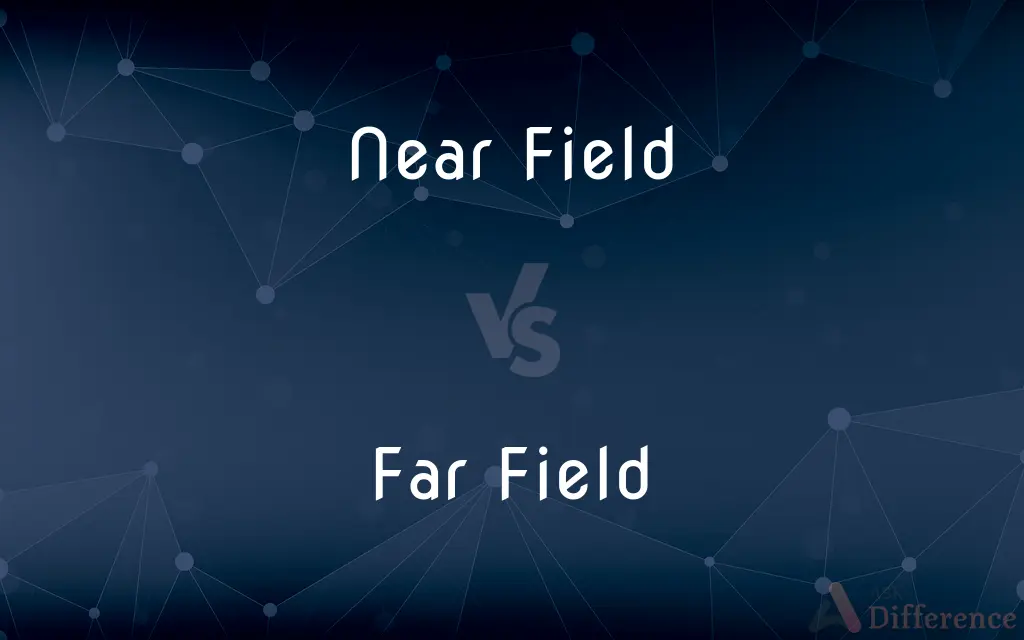Near Field vs. Far Field — What's the Difference?
Edited by Tayyaba Rehman — By Fiza Rafique — Published on August 3, 2024
Near field refers to the region close to an antenna where the electromagnetic field does not radiate, while far field is where the field spreads out and radiation occurs effectively.

Difference Between Near Field and Far Field
Table of Contents
ADVERTISEMENT
Key Differences
The near field and far field are concepts that describe the different regions around an antenna or electromagnetic source. The near field, also known as the reactive field, is the area immediately surrounding the antenna, typically within a few wavelengths. On the other hand, the far field, or radiative field, is the region where the distance from the antenna is much greater than the wavelength of the emitted radiation.
The transition from near field to far field is marked by the Fraunhofer distance, which depends on the wavelength of the radiation and the dimensions of the antenna. The near field is characterized by a complex distribution of electromagnetic fields and is important for applications like wireless charging, where energy transfer occurs over short distances without radiative processes. In contrast, the far field's simpler, radiative characteristics are crucial for long-distance communication, such as radio and television broadcasting, where signals need to travel long distances without significant loss of energy.
The behavior of electromagnetic fields in these regions has significant implications for the design and operation of antennas. In the near field region, the strength of the fields can vary dramatically, and interference effects are more pronounced. Conversely, in the far field, the electromagnetic waves spread out and diminish in intensity with distance, following the inverse square law. This predictability simplifies the analysis and design of communication systems intended for longer ranges.
Measurements and predictions of antenna performance also differ between the near field and far field. Near field measurements can provide detailed information about the electromagnetic field close to the antenna, useful for optimizing antenna design and ensuring safety standards are met, especially in environments with strict exposure limits. Far field measurements, however, are focused on determining the antenna's radiation pattern, gain, and effective area, which are critical for ensuring reliable and efficient communication over longer distances.
Understanding the distinction between near field and far field is essential for optimizing electromagnetic applications across various industries. For instance, in medical devices that use electromagnetic fields for diagnostics or treatment, ensuring the correct field behavior can significantly impact both efficacy and safety.
ADVERTISEMENT
Comparison Chart
Distance from Source
Within a few wavelengths of the antenna.
Much greater than the wavelength.
Field Behavior
Non-radiative, complex electromagnetic fields.
Radiative, fields diminish with distance.
Electric and Magnetic Fields
Not necessarily perpendicular to each other.
Perpendicular to each other and to the direction of propagation.
Applications
Wireless charging, close-range communication.
Long-distance communication, broadcasting.
Measurement and Analysis
Focus on electromagnetic field distribution.
Focus on radiation pattern, gain, effective area.
Compare with Definitions
Near Field
The region close to an antenna where electromagnetic fields are predominantly non-radiative.
Wireless charging employs near field interactions to transfer energy.
Far Field
Radiation pattern, gain, and effective area for performance evaluation.
Far field measurements help optimize antenna designs for better signal coverage.
Near Field
Detailed field distribution for optimizing design and safety.
Near field measurements are crucial in ensuring compliance with exposure limits.
Far Field
Radiative, with electric and magnetic fields perpendicular to each other.
Far field radiation patterns are critical for designing communication antennas.
Near Field
Ideal for short-range communication and wireless power transfer.
NFC technology uses the near field for secure, close-range data exchange.
Far Field
The region where electromagnetic fields spread out and diminish in intensity with distance.
Broadcast antennas rely on far field radiation to transmit signals over long distances.
Near Field
Requires careful design to manage interference and optimize efficiency.
Antenna design for near field applications focuses on maximizing energy transfer.
Far Field
Focuses on maximizing range and minimizing energy loss.
High-gain antennas are developed to enhance far field communication capabilities.
Near Field
Complex and variable, not following the inverse square law.
Near field strength can vary greatly, affecting devices like RFID tags.
Far Field
Essential for long-distance communication and broadcasting.
Satellite communication systems are designed based on far field propagation.
Near Field
In loudspeaker acoustics, referring to a region where the intensity of direct, unreflected sound from the source (such as a loudspeaker) is significantly dominant over any indirect or reflected sound.
Far Field
(telecommunications) Of or pertaining to the far field, the region sufficiently distant from a radio antenna for angular field distribution to be independent of distance.
Common Curiosities
What is the Fraunhofer distance?
The Fraunhofer distance marks the transition from near field to far field, depending on the wavelength and dimensions of the antenna.
Can the same antenna operate effectively in both near field and far field regions?
While an antenna can affect both regions, its design is usually optimized for either near field or far field applications, not both.
Why are near field and far field concepts important in antenna design?
These concepts guide the design and application of antennas, ensuring optimal performance for specific uses, such as wireless charging or long-distance communication.
What defines the near field region around an antenna?
The near field region is defined by the area immediately around an antenna, typically within a few wavelengths, where electromagnetic fields are non-radiative.
How does the far field differ from the near field?
The far field is characterized by radiative electromagnetic fields that diminish in intensity with distance, unlike the complex and variable fields of the near field.
What role does the far field play in telecommunications?
The far field is crucial for telecommunications, as it enables the effective radiation and propagation of signals over long distances.
How are near field measurements used in technology development?
Near field measurements provide detailed insights into electromagnetic field distributions, crucial for optimizing device design and ensuring safety.
How do near field applications benefit from the complex field behavior?
Near field applications, like RFID, utilize the complex field behavior for efficient short-range communication and power transfer.
Why is the perpendicular nature of fields significant in the far field?
This perpendicular arrangement in the far field ensures efficient radiation of energy and is fundamental to understanding antenna radiation patterns.
Can far field concepts apply to sound waves as well as electromagnetic waves?
Yes, far field concepts also apply to sound waves, where similar principles govern the propagation of sound in open spaces.
How do environmental factors influence near field and far field behaviors?
Environmental factors, such as obstacles and atmospheric conditions, can affect field propagation, with more pronounced effects in the near field due to its complexity.
What is the significance of the inverse square law in far field analysis?
The inverse square law explains how electromagnetic field strength decreases with distance in the far field, crucial for signal strength calculations.
How do design considerations differ for near field and far field applications?
Design for near field focuses on maximizing energy transfer and managing interference, whereas far field design aims at maximizing range and minimizing energy loss.
What future technologies might further exploit near field and far field distinctions?
Future technologies may include advanced wireless power transfer systems, more efficient communication networks, and innovative sensing and diagnostic tools leveraging the unique properties of each field region.
What challenges arise in transitioning from near field to far field measurements?
Challenges include ensuring measurement accuracy and relevance across different scales and field behaviors, requiring diverse techniques and equipment.
Share Your Discovery

Previous Comparison
Amstaff vs. Pit Bull
Next Comparison
Cold vs. FluAuthor Spotlight
Written by
Fiza RafiqueFiza Rafique is a skilled content writer at AskDifference.com, where she meticulously refines and enhances written pieces. Drawing from her vast editorial expertise, Fiza ensures clarity, accuracy, and precision in every article. Passionate about language, she continually seeks to elevate the quality of content for readers worldwide.
Edited by
Tayyaba RehmanTayyaba Rehman is a distinguished writer, currently serving as a primary contributor to askdifference.com. As a researcher in semantics and etymology, Tayyaba's passion for the complexity of languages and their distinctions has found a perfect home on the platform. Tayyaba delves into the intricacies of language, distinguishing between commonly confused words and phrases, thereby providing clarity for readers worldwide.













































